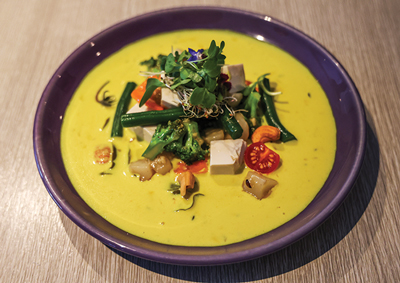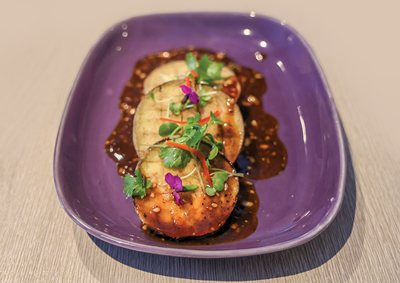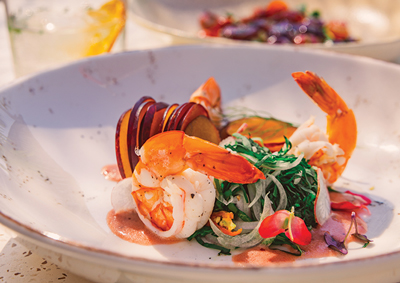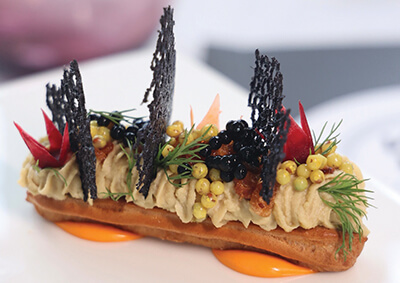Preserving Goan Culture
Chef Avinash Martins....Preserving Goan Culture

Text: Shilpi Madan
Photograph: Farzana Contractor
“I always follow my heart,” says Chef Avinash Martins. His narrative menus make him India’s foremost contemporary storyteller and preserver of Goan culture. No wonder, as the heart-driven chef is powering the food and farming traditions of his homeland, marrying age-old techniques with innovative flavours in the energy and experiences he serves at his restaurants, Cavatina and Table in the Hills (TITH) in South Goa.
Avinash comes from a family of master mariners, and grew up amidst lipsmacking meals both on and off the ships. “Food was always the centre point, with breakfast and lunches on board filled with cured sausages and Spanish ham, tinned sardines and tuna, different kinds of cheese... “My family was disappointed when I decided not to pursue the family tradition of travelling across the seas, and instead take to food, my core love,” he says, having been trained by The Oberoi Hotels before returning to his home in Goa.
Cavatina, his flagship restaurant, and Table in the Hills located on his family farm – both in Goa – are netting hearty acclaim owing to his natural ability to bring together all his passions: slow food, clean eating and sea-to-table food. All while Avinash is leading a creative cohort of toddy tappers, farmers, and storytellers to reaffirm the heritage of the coastal stretch he belongs to. “I believe in Goan food, and in its goodness,” he says. “For example, toddy tappers are dwindling now, with the profession demanding climbing atop coconut trees over 300 times a day to retrieve the fresh sap of the fruit. I have enrolled a group of toddy tappers as my suppliers and make use of the indigenous juice to bring in a sourish taste to everything from rice cakes to phanas, pancakes, even vinegar and feni. Our food is linked to the toddy. I make my bread and cakes too using the toddy. When guests eat, the flavours take them back to their childhood. For me, that is the mark of a successful dish – how well it lives up to the nostalgia of the past.”
The chef’s signature Hay Mackerel is a rustic recipe, bringing in the smoky flavours of the first ingestion of the fishermen netting the early morning catch. “Why not give a traditional dish the recognition it deserves? Memories of my childhood in Goa are ingrained in me. I had the opportunity to settle anywhere in the world but my heart was always in Goa. How could I leave and go?” he confesses. “I came back to revive our culinary heritage and put our food artisans, the farmers and toddy tappers, on the global culinary map. When I serve a dish, I am putting their story on the table.” The charcoal flavours are drawn in from coconut shells, as local kulli cutlets and crab bisque appear even on the monsoon menu. Not surprising as Avinash uses the land and the sea as his grocery store. “I do not have to cross the boundary of my village, Velim, as within a five-km radius I have everything, from coconut trees to a lake. When it rains, the pond brings in fresh catch. That’s the beauty of being in Goa, everything is around in all seasons.”
It is very tough to get a table at Cavatina. Gourmet gospels abound in a delicious mating of Goan, Italian and Spanish cuisines. Amber pools, soft jazz (Avinash often strums the guitar spontaneously with his team) and pinch-me moments in darling dishes compose the experience. Even the traditional poi is served with a slice of flair with the server reciting a poem explaining the origins of the signature Goan bread. Prawn and chorizo cigars (arranged stylishly in a signature humidor), the elegantly perched Nest in the Woods jackfruit special in a potato nest on a wooden log champions the delicious mock meat, and in keeping with his anthem of ‘eat local, live global’, Avinash deftly elbows aside the traditional spinach with the local tamdi in his version of the Greek spanakopita. Call it multi-layered fusion cuisine.
A bigger coup is clinching a place at a table at the 12-seater Table in the Hills, located on his family farm laced with cashew and mango orchards. It is an intimate setting, where spring water is served (there is no PWD here!) as Avinash goes about making his batch of sauces in mud pots for that sense of earthiness, and slow-smoked meats using the fallen mango and cashew wood that breathe in their own distinctive flavours. “I smoke 5-7 kgs of pork belly overnight using the different woods. Believe me, there is no way these flavours can be gained in a restaurant kitchen,” shares the chef. The carbonara thrills, unfurling like a pirouetting ballerina on your palate. Just like the pulled duck that composes the mouth-watering belly of the Bihari litti chokha.
The learning never stops for Avinash. He recently spent a month with the tribals in the forest. “I lived there, and discovered the nutritious secretion the dry kokum seed releases on being pressed. This kokum fat has been used by our ancestors 600 years ago as they had no access to cooking oil. With over eight varieties of sweet potato in sweet, savoury and sticky forms, I have begun using these as thickening agents for curries and soups,” he says, going about what he does best – imagining flavours and pairing different ingredients, all while favouring the imam dasta (mortar pestle) in the kitchen over the blender.
“Music travels with me everywhere. I wear my pods while cooking, and play the same song in a loop while making a dish,” grins Avinash, lending a peep into his eclectic culinary genius. What’s next? “Healing people through my food. Indian food is unique as it carries Ayurvedic properties. For me, food is inseparable from a deep sense of gratitude, and I want to take this healing power of food to everyone.”







